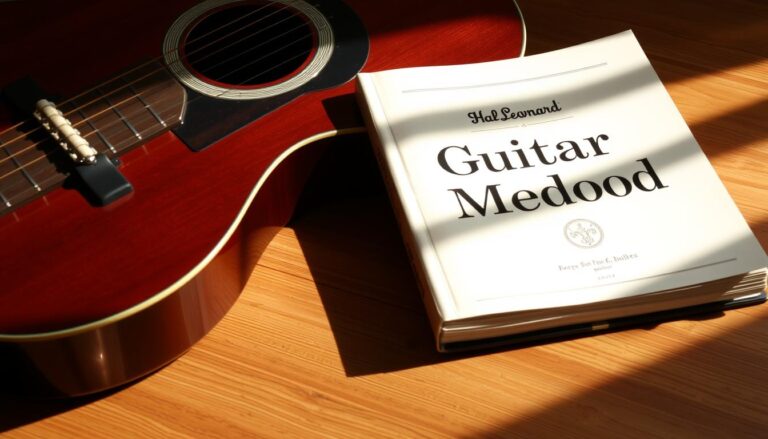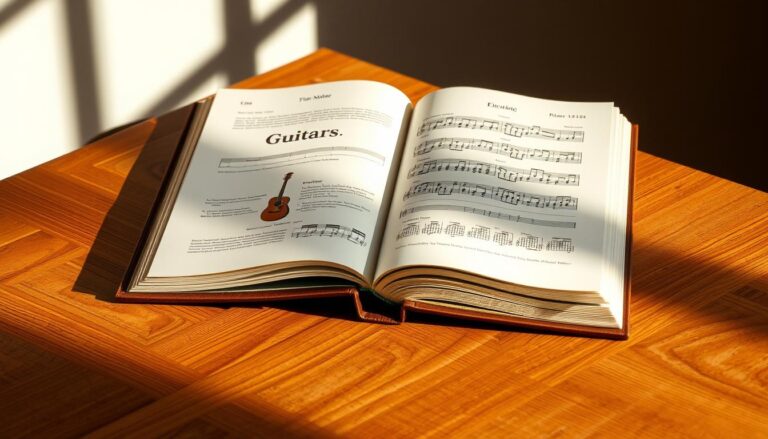Staff Paper Note Book for Musicians
This roundup evaluates common options for composers and educators. It compares format, durability, and total cost of ownership across budget to premium units. The analysis covers brands such as Henle, Judy Green Music, Archives, Moleskine, Leuchtturm1917, and The Musician’s Notebook.
The review examines manuscript layouts, stave density, line weight, and binding performance to assess readability and notation efficiency. It also profiles published price points and unit value for pocket, classroom, and large-format use cases. Practical factors such as flat‑lay capability, tear‑off convenience, and archiving workflows inform procurement choices for recurring spend and quality control.
Key Takeaways
- Format and layout drive notation speed and legibility for composition work.
- Price tiers range from low-cost Jotters to higher-value Moleskine and Leuchtturm1917 options.
- Manuscript paper quality and stave density affect rehearsal and scoring efficiency.
- Binding and perforation determine durability and archive readiness for a project book.
- Choice aligns with use case: pocket capture, classroom pads, or large-format scores.
Why This Product Roundup Matters for Working Musicians and Music Educators
Practical differences in line darkness, margin spacing, and flat‑lay capability change daily notation habits for professionals and classrooms. These attributes affect speed, accuracy, and the likelihood that an idea becomes a finished composition.
Field observations show overly dark staves reduce legibility and that weak bindings prevent true flat‑lay writing. Higher price points can discourage spontaneous idea capture, while low‑cost options encourage frequent drafting and project segregation.
Operational priorities for working musicians and educators include consistent manuscript paper quality, reliable bindings, and predictable replenishment costs.
- Durable pages and flat‑lay performance to enable hands‑free notation during rehearsals.
- Format and margins that support harmonic notes, comments, and quick analysis.
- Price sensitivity: affordable units like Henle Jotters enable routine sketches; classroom formats such as the Ruled Edition streamline dictation and grading.
This roundup compiles verified prices and features to reduce search time and lower the risk of purchasing unsuitable tools for daily writing and notation workflows.
How to Choose the Right Music Manuscript Notebook
Selecting the right manuscript format begins with measurable paper attributes and binding choices that affect speed and legibility. Evaluate core variables rather than aesthetic features alone.
Paper weight, line thickness, and stave spacing
Confirm sheet weight and surface sizing to ensure clean erasing and minimal ghosting with softer pencil leads. Lighter stock may crease; heavier stock resists bleed from markers.
Check stave line darkness. Overly bold lines impede rapid notation and reduce contrast for dense harmonic writing. Opt for medium line weight and consistent stave spacing that matches your instrumentation density.
Binding types: spiral, pad, stitched, hardcover
Match binding to workflow: spiral bindings lay flat for live notation and quick page turns. Pads and perforated formats enable tear‑off rearrangement for score assembly.
Stitched and hardcover formats increase longevity and protect pages during travel. Some hardcovers include facing blank pages for analysis and a built‑in ruler for adding extra staves.
- Durability: Reinforced spines and cover materials reduce edge wear in rehearsal settings.
- Legibility: Match line thickness and spacing to notation density—wider spacing for orchestration, tighter for lead sheets.
- Accessories: Confirm compatibility with staff rulers and templates to expand or customize systems on demand.
Best Staff Paper Notebook Picks for Musicians
The list focuses on proven format choices and unit prices that influence daily composing and archiving. Each option aligns to a defined use case: pocket capture, daily composing, premium binding, or large‑format scoring.
Henle Music Folios “Jotter for Notes” — Small and Large
Price: small ~$1.50, large ~$4.50. Henle prioritizes ultra‑low unit cost and narrow format for single‑project capture. These are ideal when few pages per project simplify archiving and reduce storage overhead.
Judy Green Music 6‑Stave Pads
Price: ~$12.50. Judy Green pads deliver a smooth graphite feel for 0.9 mm soft leads. Tear‑off sheets and consistent stave spacing make them efficient for daily composition and quick revisions.
Moleskine Large Hardback and X‑Large Softcover
Price: large $19.95; x‑large 3‑pack $22.95. Moleskine offers premium paper, a staff ruler, and a blank facing page in the large version. The trade‑off is higher price but increased durability and presentation value.
Archives 18‑Stave Score Pad and Spiral
Price: ~$13.50. Archives provides economical large pages for full scores and layout at a glance. Suitable for arrangers needing wide stave density and extended sheets.
Leuchtturm1917 Music Book & The Musician’s Notebook Ruled Edition
Leuchtturm1917 adds an index feature for cataloging works. The Musician’s Ruled Edition combines college‑ruled notes with ten staves on the facing page, and includes perforation plus three‑hole punching for classroom workflows.
Selection should weigh pages per book, staff density, paper brightness, and binding durability to match the intended composition task.
Pocket and Small Formats for On‑the‑Go Notation
Small-format options emphasize rapid access, low unit cost, and straightforward project indexing for frequent note-taking. These units suit musicians who need immediate capture without digital dependency.
The Henle “Jotter for Notes” small is priced around $1.50 per book. Its narrow profile supports dedicated project archiving and reduces storage footprint. Low price enables buying multiple units to separate ideas by session or arrangement.
The Moleskine pocket music journal is discontinued but remains a benchmark. Its hard cover demonstrated how protection and portability improve longevity in transit and live settings.
Practical evaluation
- Compact pages enable motif capture in transit without power or apps.
- Bindings must resist frequent opening; flat‑lay improves speed during rehearsals.
- Paper quality should accept soft pencil leads and resist smearing during quick edits.
| Feature | Henle Jotter (Small) | Moleskine Pocket (Legacy) |
|---|---|---|
| Price | $1.50 | $19–22 (historic retail) |
| Format | Narrow, project-friendly | Hardcover, durable |
| Use case | Multiple project capture | Long-term portability and presentation |
Classroom and Lesson Notebooks Designed for Daily Use
The Musician’s Notebook Ruled Edition is configured for instruction and rehearsal workflows. It pairs college‑ruled text pages on the left with ten stave lines on the right. Every sheet is perforated and three‑hole punched to streamline submission, copying, and binder integration for teachers and students.
The mixed layout supports analytical writing beside notation, which aids retention in theory coursework and melodic dictation exercises. The build resists edge wear during daily transport and reduces page detachment under frequent handling.
- Dual layout: lined annotation opposite consistent staves for assignments and feedback.
- Perforations: enable rapid distribution of parts and student submissions.
- Three‑hole punch: fits standard US binders to lower administrative overhead.
Institutions can plan price and replacement cycles by standardizing on page counts and formats. Choice between pad and bound books depends on archival policy, grading workflows, and ease of collection during term‑end processing.
| Feature | Ruled Edition | Typical Pad | Binder-Friendly Pack |
|---|---|---|---|
| Left page | College‑ruled lines | Notes or blank | Ruled or blank |
| Right page | 10 staves per page | 5–12 staves | Customizable density |
| Perforation | Every page | Occasional | Yes |
| Hole punching | 3 holes standard | None | 3 holes |
| Use case | Theory, dictation, lessons | Quick sketches, pads for rehearsals | Course archives and binders |
Large-Format and Score Pads for Composers and Arrangers
Large-format scoring gives composers a complete visual field for orchestration and form decisions. Archives offers two 18‑stave options — Spiral Bound and Score Pad — each priced at approximately $13.50.
Archives 18‑stave Spiral vs. Score Pad — when to pick each
The Archives 18‑stave Spiral is optimal when flat‑lay stability and reliable page turns matter during drafting or rehearsal. It keeps systems aligned and supports consecutive notation without shifting.
The Score Pad is preferable when compositions require physical rearrangement. Tear‑off sheets let arrangers reorder sections, test forms, and assemble parts for copyists.
Laying out full scores, forms, and sections at a glance
Large pages with many staves increase visibility of vertical alignment and instrumentation balance. That clarity reduces notation errors and speeds review cycles.
Pencil and eraser performance on large formats should preserve line clarity through dense notation and longer sessions. Both Archives formats deliver consistent stave spacing to lower interpretation risk in complex scores.
- Spiral: flat‑lay, stable page turns, keeps revision history bound.
- Score Pad: tear‑off sheets, ideal for form experiments and shuffle workflows.
- Cost per page is economical versus premium bound volumes, supporting iterative composition without price hesitation.
| Feature | Archives 18‑stave Spiral | Archives 18‑stave Score Pad | Price (approx.) |
|---|---|---|---|
| Primary use | Drafting, rehearsals | Rearrangement, part prep | $13.50 |
| Binding | Spiral, flat‑lay | Perforated pad, tear‑off sheets | |
| Revision workflow | Bound history retained | Shuffle and assemble | — |
| Notation clarity | Uniform stave spacing | Uniform stave spacing | — |
Paper and Print Quality: Legibility, Stave Darkness, and Pencil/Pen Performance
Legibility and tactile response determine whether a manuscript sheet supports rapid notation or forces repeated corrections. Professionals prioritize contrast, opacity, and surface finish to reduce mistakes during rehearsals and revisions.
Practitioner reports highlight two consistent preferences: medium‑weight pages that resist show‑through, and moderate stave darkness that preserves symbol clarity. Brands such as Moleskine and Judy Green are noted for smooth surfaces that pair well with 0.9 mm soft leads.
- Brightness & opacity: Prevents show‑through while keeping strong contrast with graphite and ink.
- Stave darkness: Excessive line weight reduces legibility and raises error rates in sight revisions.
- Surface finish: Smoother sheets lower friction for soft pencils and fine pens, improving speed.
- Print registration: Uniform placement ensures consistent bar spacing and proportional notation across pages.
- Erase and ink behavior: Good sizing avoids fiber lift, smearing, feathering, and long drying times.
Quality control in print and material selection minimizes rework and supports professional score presentation. These criteria should guide procurement decisions for any music manuscript or classroom notebook purchase.
Bindings and Durability: Flat-Lay Writing vs. Tear-Off Convenience
Binding choice determines whether a manuscript lays flat for notation or supports quick sheet removal for rearrangement. Spiral bindings offer the most reliable flat‑lay writing for extended sessions and rehearsals.
Pads excel when iterative arranging or collaboration requires rapid tear‑off and reordering of sheets. Clean perforation and measured page retention are critical to avoid torn margins during assembly.
Stitched and casebound constructions provide long‑term durability and a protective cover for travel. Their lay‑flat performance varies; procurement should test hinge integrity and edge protection before bulk purchase.
- Spiral: best flat‑lay stability and consistent notation alignment.
- Pads: fastest teardown and reassembly for arrangement workflows.
- Stitched/casebound: durability and archivability, with variable lay‑flat behavior.
“Page retention strength should balance durability with clean perforation where applicable.”
Recommendation: match binding mechanics to the working environment—stand use favors spirals, desk use accepts stitched volumes, and on‑lap notation benefits from lightweight pads.
Price and Value: What You Can Expect to Pay Today
Cost per page and binding type shape how departments budget for recurring manuscript purchases.
This section summarizes list prices and practical value across low‑cost project books, midrange pads, and premium volumes.
Henle Jotter — project books
Price: small ≈ $1.50; large ≈ $4.50. Henle units have low sheet counts and work well as single‑project books.
Judy Green & Archives — economical format
Price: Judy Green pad ≈ $12.50; Archives Spiral/Score Pad ≈ $13.50. These midrange choices give favorable price‑to‑format ratios for daily composing and scoring.
Moleskine — premium considerations
Price: large hardcover $19.95; x‑large softcover three‑pack $22.95. Higher list prices buy refined build and presentation but may reduce spontaneous drafting.
- Procurement tip: calculate effective cost per page and expected consumption to forecast annual spend.
- Value factors: stave clarity, binding durability, and consistent print justify higher price points.
- Mix strategy: budget books for capture, midrange pads for daily work, premium for presentation.
| Product | Price (approx.) | Primary use | Pages / Format |
|---|---|---|---|
| Henle Jotter (small) | $1.50 | Project capture | Few pages, narrow |
| Judy Green Pad | $12.50 | Daily composing | Perforated pad, many pages |
| Archives Spiral / Score Pad | $13.50 | Large‑format scoring | 18‑stave pages |
| Moleskine Large / X‑Large | $19.95–$22.95 | Presentation & archival | Hardcover or softcover volumes |
Cover Styles, Sizes, and A4 Options Worth Considering
A4 formats and color options provide a pragmatic balance between desktop layout and transport weight. This size fits music stands while keeping a clean notation field for orchestration and phrasing.
A4 large formats and colorways
Available colorways include Arctic Teal, Beige Cork, Charcoal Black, Chestnut Brown, Dartmouth Green, Rose Wood, Scarlet Red, and Symphony Blue. All eight are listed in stock and frequently show a Save 11% promotion.
Color coding simplifies project organization by ensemble, course, or phase and reduces search time when handling multiple assignments.
Hardcover vs. softcover vs. pad
Hardcover maximizes spine rigidity and travel protection. It supports filing and long‑term archiving.
Softcover lowers carry weight and is preferable for daily travel and quick idea capture.
Pads favor tear‑off workflows and temporary layouts when frequent editing or reordering is required.
- Match page layout and stave count to instrumentation density to avoid wasted space.
- Choose formats that reduce handling time during rehearsals and reviews.
- Monitor promotions such as Save 11% to improve unit cost on A4 inventory.
| Format | Primary advantage | Typical price note |
|---|---|---|
| A4 Hardcover | Durability, archival filing | Higher initial price; better long‑term value |
| A4 Softcover | Lightweight, portable | Lower price; suited to travel |
| A4 Perforated Pad | Tear‑off sheets, shuffle workflows | Midrange price; cost per page economical |
“Colorway options and durable covers reduce retrieval time and lower handling damage over repeated use.”
Use Cases: Idea Capture, Melodic Dictation, Jams, and Project Archiving
Workflow selection hinges on how pages move between idea capture, rehearsal, and archive. Formats that support clean handoffs reduce friction and speed delivery to copyists or course binders.
Storyboard your music: tear‑off cards and floor layouts
Judy Green pads enable storyboard composition by providing tear‑off sheets that can be arranged on the floor. This approach clarifies form, transitions, and instrumentation at a glance.
Coursework to rehearsal: moving pages from notebook to binder
The Musician’s Ruled Edition supports melodic dictation and classroom workflows with perforated, three‑hole punched pages. Instructors can collect pages without trimming, preserving student submissions and grading trails.
- Idea capture: Henle Jotters reduce hesitation with low‑friction layouts for rapid drafting.
- Jam sharing: Durable sheets and fast tear‑off enable immediate distribution of riffs.
- Archiving: Narrow or A4 books align to catalog systems and color coding for retrieval.
“Formats that match the task cut handling time and lower the risk of lost motifs.”
| Use case | Recommended format | Benefit |
|---|---|---|
| Rapid capture | Henle Jotter (narrow) | Low friction, easy project indexing |
| Class dictation | Ruled Edition (perforated) | Direct binder transfer, dual layout |
| Storyboard & arrange | Judy Green pads (tear‑off) | Shuffleable sheets for form testing |
Accessories That Improve Your Handwriting Workflow
Choosing the right pencil and ruler reduces friction between idea capture and final scoring. Small accessories influence clarity, erasure behavior, and portability in rehearsal and studio contexts.
Mechanical pencils: Pentel Twist‑Erase 0.9 mm for soft, bold lines
Pentel Twist‑Erase 0.9 mm (~$7) is recommended for smooth writing on Judy Green pads. The 0.9 mm core with soft lead makes readable, bold strokes and erases cleanly on quality paper.
Practical note: larger cores reduce graphite smearing and speed notation during fast rehearsals.
Clippable pencils and staff rulers to expand or customize staves
Clippable pencils, such as the Moleskine 0.7 mm (~$14), stay attached to a cover and lower misplacement risk during sets and lessons.
Staff rulers included with some premium volumes allow users to draw or extend staves, optimizing page real estate for dense passages and orchestration work.
- Lead thickness: 0.9 mm soft leads balance visibility and erasure.
- Carry design: clippable tools maintain readiness and reduce loss in transit.
- Rulers: add staves or align systems for cleaner notation layouts.
- Consumables: consider eraser longevity and refill availability for sustained writing.
- Ink tests: verify feathering and dry time to avoid smearing when pages turn quickly.
“Accessory selection should align with binding and cover styles to ensure secure carry and reliable on‑site performance.”
Where to Buy in the United States
Procurement choices affect availability, lead time, and the final price for A4 manuscript items. Buyers seeking consistent inventory should compare direct brand channels to specialty music retailers before placing institutional orders.
Direct brand shops and music retailers with in‑stock A4 manuscript
Direct brand shops typically list exact stock counts and full colorway choices. A4 items show In stock (8) across Arctic Teal, Chestnut Brown, Symphony Blue, and others. Brands also publish return policies for bulk buys.
Specialty music retailers carry Archives, Judy Green, and Henle models. Retailers often offer competitive shipping thresholds and single‑order support for classroom provisioning.
Watching for deals: “Save 11%” promos and multi‑pack values
Promotions such as Save 11% and multi‑pack bundles lower effective unit costs for semester or season provisioning. Verify the advertised discount against final checkout fees and shipping rules.
- Confirm colorway stock to support categorical organization across ensembles or classes.
- Check return and bulk‑order terms to mitigate procurement risk for large orders.
- Note discontinued items (for example, the Moleskine pocket music journal) and select current pocket alternatives when needed.
| Channel | Typical advantage | Action |
|---|---|---|
| Brand shop | Latest configurations; visible stock | Order sets; confirm return window |
| Music retailer | Competitive price; shipping options | Compare bundles; check thresholds |
| Wholesale / bulk | Lower per‑unit price on books | Request sample; verify color counts |
“Confirm stock counts and return policies before committing to semester or bulk purchases.”
Conclusion
A concise procurement rule: match format to task, validate print and surface quality, and confirm binding mechanics before ordering a staff paper notebook for music use.
The roundup highlights practical choices: low‑cost Henle Jotters for capture, the classroom‑ready Ruled Edition, smooth Judy Green pads, economical Archives large formats, premium Moleskine volumes, and indexed Leuchtturm1917. A4 options remain widely in stock and often show a Save 11% promotion.
Decision criteria are simple and measurable. Verify manuscript print clarity and surface sizing to protect marks on manuscript paper. Select bindings that support flat‑lay or tear‑off workflows. Use published pricing to calculate cost per page and forecast consumption. Prioritize formats that sustain efficient composition and durable page handling over time.
FAQ
What distinguishes a quality music manuscript notebook from a standard composition book?
A quality music manuscript notebook uses heavier sheets, clearly printed staves with appropriate spacing, and paper that accepts pencil and ink without excessive bleed or smudging. Important technical specifications include paper weight (measured in gsm), stave darkness and spacing (measured in mm), and margin/format options such as indexed pages or perforations for file storage. These factors affect legibility, archival durability, and ease of notation for professional use.
Which binding type is best for composers who need both flat‑lay writing and easy page removal?
Spiral and stitched hardbacks offer complementary benefits. Spiral bindings provide true flat‑lay performance, enabling full-score layout without seam distortion, while stitched or sewn hardcovers deliver superior long‑term durability and archival stability. Perforated pads and three‑hole punched pages combine tear‑off convenience with binder integration for lesson or rehearsal workflows.
How should a working musician select stave spacing and line thickness for different tasks?
Choose wider stave spacing (e.g., 12–18 mm) for orchestral scoring and legibility in conductor or arranger settings; tighter spacing (e.g., 8–10 mm) suits lead sheets and sketching. Line thickness affects contrast: darker, thicker staves aid photocopy and scanning, while lighter lines reduce visual clutter for dense orchestration. Match spacing to typical notation density and the writing tool (0.9 mm pencil versus fine‑tip pen).
Are there reliable budget options that still meet professional needs?
Yes. Economical pads with heavier stock and larger stave formats can deliver professional results for drafting and rehearsal. Low‑cost options with 18‑stave layouts or standard 6‑stave pads provide adequate paper weight and stave quality for daily composing. Cost‑effective products are suitable when combined with proper storage and scanning for archival copies.
What paper weights and finishes should procurement specialists request for bulk orders in educational settings?
For classroom and lesson notebooks, specify 80–120 gsm uncoated stock to balance cost, durability, and pencil/ink performance. Uncoated, slightly textured finishes reduce smearing and improve graphite adhesion. For archival or score production needs, recommend 120–160 gsm acid‑free paper to ensure longevity and consistent scanner reproduction.
How do large‑format score pads compare to spiral score books for arranging and full‑score layout?
Large‑format score pads typically offer single‑sheet removal and cost efficiency for big layouts, while spiral score books provide uninterrupted spread views and repeated use without losing sequence. Choose pads when individual sheets will be scanned or posted; choose spiral books when working across multiple systems and needing continuous spreads for sectional alignment.
Where are the most reliable procurement channels in the United States for manuscript pads and bound music books?
Purchase directly from established brands and authorized music retailers to ensure consistent stock and authentic specifications. Major music retailers, specialist stationary suppliers, and direct brand shops carry A4 manuscript formats and multi‑pack values. Monitoring promotional cycles and volume discounts yields cost savings for institutional orders.






